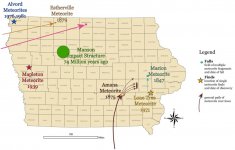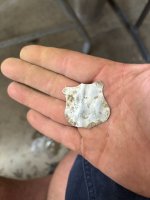collins6542
Full Member
- Feb 12, 2017
- 103
- 168
- Detector(s) used
- Minelab E-TRAC, Garrett AT Gold, SunRay X-1 Probe
- Primary Interest:
- Prospecting
Below is a passage I stumbled across while digging through the Iowa Geological Survey! Check out the read!
The arrival of the first of Iowa’s historic meteorites at 2:50 p.m. on February 25, 1847, was announced with a great blast, described as sounding like the rolling of “distant thunder” followed by “three reports … in quick succession, like the firing of heavy cannon a half mile distant.” C.W. Irish, a civil engineer reported that the explosions were “distinctly heard at Iowa City, twenty-two miles south from the place of the fall, and great was the alarm caused by them.” He went on to speculate that the meteor had moved from south to north passing directly over the city. Interestingly, the meteorite passed over Iowa City on the same day that Governor Ansel Briggs signed legislation from Iowa’s First General Assembly creating the State University of Iowa. Several observers saw fragments of the Marion Meteorite strike the ground, and at least five fragments were recovered, with a combined weight of about 75 pounds. The Marion Meteorite was described as a uniform pearl gray in color, with small specks of rust-red iron and numerous highly brilliant globules of nickeliferous iron, and is classified as an achondrite.
The Amana Meteorite
The Amana Meteorite flashed into Iowa between 10:00 and 11:00 pm on Friday February 12, 1875. Its bright fireball was visible from Omaha to Chicago and St. Paul to St. Louis. The meteorite entered the atmosphere over northern Missouri and traveled in a north-northeasterly direction, passing a couple of miles east of Centerville, and directly over Eddyville before exploding and breaking into two main pieces over northwest Keokuk County. The larger fragment continued north, finally exploding near the Iowa-Benton county line southwest of Norway. No samples of this fragment were ever recovered. The course of the smaller fragment was deflected to the east, and it exploded over Amana, producing a meteorite field approximately 3 miles wide and 5 miles long. A total of about 800 pounds of the Amana meteor, classified as a dark chondrite, were recovered from this field, the largest fragment weighing about 74 pounds. It is estimated that about 3½ tons of the Amana Meteorite have not yet been recovered from the northern and southern fall locations.
Estherville Meteorite
About 5:00 in the afternoon of May 10, 1879, a loud roar from the west announced the appearance of another visitor from space, the Estherville Meteorite. The meteorite appeared to observers as a bright red streak in the clouds, suddenly becoming a brilliant white as it burst through the clouds and exploded producing three primary fragments and a rain of smaller stones. Each of the larger fragments trailed a ribbon of smoke, with the largest observed to impact the earth about 1½ miles west of Estherville in Emmet County. Hurrying to the impact site, the observers discovered a funnel-shaped crater in the swampy soil, 10 to 12 feet in diameter filled with mud and water. After digging in the crater for two days the main mass of the meteorite, weighing about 430 pounds was raised from the hole. A second fragment weighing 151 pounds was found four days later about 3 miles away, and a third large fragment, weighing 101 pounds, lay undiscovered for over 9 months until it was found buried 5 feet below the surface in a slough. During the late summer of 1879 a prairie fire swept across the area, exposing hundreds of small meteorite fragments that lay in a strewn field measuring 6 miles long and up to 1½ miles wide. Although the Estherville Meteorite was reported by some people to be “almost perfectly ductile,” and rings and other ornaments are reported to have been made from pieces of the fragments, analysis indicates that the stone should be classified as a chondrite.
The Forest City Meteorite appeared out of the west about 5:15 pm on May 2, 1890, momentarily outshining the sun in a cloudless sky. With a head compared to the size of a full moon, observers reported a roaring sound, “Sputtering” and throwing off a long train of sparks and trailing a heavy line of black smoke. As observed from Grinnell (about 100 miles away) the meteor required only a few seconds to pass from horizon to horizon. Other sightings of the meteorite were reported from Chamberlain (South Dakota), Sioux City, Humboldt, Ruthven, Des Moines, and Mason City. The meteorite exploded about 11 miles northwest of Forest City raining rock fragments on an area about four miles long and 1.5 to 2 miles wide near the town of Thompson. Thousands of pieces of the Forest City Meteorite, totaling about 269 pounds, were recovered, the largest weighing 81, 75, and 66 pounds The meteorite is a typical olivine-bronzite chondrite displaying chondrules of olivine and pyroxene from 0.3 to 2 mm in diameter.
Mapleton Meteorite
The fall of the Mapleton Meteorite was not observed. The meteorite was discovered on June 17, 1939 by a farmer who was cultivating his field a few miles east of Mapleton in Monona County. Having struck the stone, he stopped his team and dug it out, and finding it “heavier than any other stone”. At some later date, he and his neighbors examined the rock more closely and realized its similarity to the iron meteorites described in the current (July 1939) issue of the National Geographic Magazine, and thus the Mapleton Meteorite was identified. Although its fall was not directly observed, some people speculated that the body was related to a great fireball observed in the area on Thanksgiving night in 1916, but this relationship is not proven. The Mapleton Meteorite weighed 108 pounds when found and has been classified as a iron meteorite of the medium octahedrite class.
Lone Tree Meteorite
The Lone Tree Meteorite was discovered during cultivation in May 1972 about 3 miles southwest of Lone Tree in southern Johnson County. Although no one observed the fall of the stone, its discovery in fine-grained glacial outwash soil indicates that it was discovered where it fell, and was not transported to the site by glaciers, rivers, or other natural forces. When discovered, the meteorite had a yellowish brown exterior color and weighed about 46 pounds. Several slices were cut from the stone for analyses. One of these slabs, displayed below, is on loan from the University of Iowa. Analyses showed the meteorite to be classified as a chondrite.
Alvord Meteorite
The Alvord Meteorite was found on or around June 5, 1976, on a farm about 13 miles southeast of the Lyon County town of Alvord. Arnis History of Meteorites lists it as weighing 17.5 kg (38.5 lbs) when found and being an iron octahedrite (IVA). The find location was listed as 43º 19’ 20” N, 96º 17’ 20” W. New information indicates that the meteorite was found by Herbert Van Engen on the John Mulhall farm, T98N, R46W, Sec 09, north half, about a mile southeast of Alvord. The meteorite was eventually sold to the National Museum of Natural History, Smithsonian Institution for $800, however a slab was cut and retained by the Van Engen family as a souvenir. The slab is currently owned by Ellis Voss of Ames, Iowa. A second piece was found in 1981 during Fall plowing by Jim Kelly. This fragment weighed 39 pounds and was found in T98N, R46W, Sec 03, southwest quarter, about 1.5 miles southeast of Alvord. This sample was sold to the Smithsonian Institution for $800. Jim Kelly also reported that a curve on the “outside” of the meteorite suggested that the original body was about the size of a “medicine ball” (about 18” in diameter) and he believes that it fell in the 1910s when his father observed an explosion in the sky that was attributed at the time to an exploding meteorite.
Manson Impact Structure
The Manson Impact Structure is a 23 miles-diameter meteorite impact crater centered near the town of Manson, about 20 miles west of Fort Dodge. The crater was produced by the impact of a 1.5 mile-diameter asteroid into a shallow inland sea that covered the area 74 million years ago, a period of time known to geologists as the Late Cretaceous. Upon impact, the asteroid exploded with an energy of 10 thousand-million-million kilotons of TNT (10,000 times the energy released in the eruption of the Mount St. Helens Volcano.) The blast excavated a crater about 5 miles deep, throwing debris to the farthest reaches of the earth and killing most of the animals in the region that is now the central United States. The tremendous energy of the impact blast vaporized the entire impacting asteroid The Manson crater, the 15th largest crater on earth, lies at the bedrock surface, buried by 100-300 feet of glacial till.
The arrival of the first of Iowa’s historic meteorites at 2:50 p.m. on February 25, 1847, was announced with a great blast, described as sounding like the rolling of “distant thunder” followed by “three reports … in quick succession, like the firing of heavy cannon a half mile distant.” C.W. Irish, a civil engineer reported that the explosions were “distinctly heard at Iowa City, twenty-two miles south from the place of the fall, and great was the alarm caused by them.” He went on to speculate that the meteor had moved from south to north passing directly over the city. Interestingly, the meteorite passed over Iowa City on the same day that Governor Ansel Briggs signed legislation from Iowa’s First General Assembly creating the State University of Iowa. Several observers saw fragments of the Marion Meteorite strike the ground, and at least five fragments were recovered, with a combined weight of about 75 pounds. The Marion Meteorite was described as a uniform pearl gray in color, with small specks of rust-red iron and numerous highly brilliant globules of nickeliferous iron, and is classified as an achondrite.
The Amana Meteorite
The Amana Meteorite flashed into Iowa between 10:00 and 11:00 pm on Friday February 12, 1875. Its bright fireball was visible from Omaha to Chicago and St. Paul to St. Louis. The meteorite entered the atmosphere over northern Missouri and traveled in a north-northeasterly direction, passing a couple of miles east of Centerville, and directly over Eddyville before exploding and breaking into two main pieces over northwest Keokuk County. The larger fragment continued north, finally exploding near the Iowa-Benton county line southwest of Norway. No samples of this fragment were ever recovered. The course of the smaller fragment was deflected to the east, and it exploded over Amana, producing a meteorite field approximately 3 miles wide and 5 miles long. A total of about 800 pounds of the Amana meteor, classified as a dark chondrite, were recovered from this field, the largest fragment weighing about 74 pounds. It is estimated that about 3½ tons of the Amana Meteorite have not yet been recovered from the northern and southern fall locations.
Estherville Meteorite
About 5:00 in the afternoon of May 10, 1879, a loud roar from the west announced the appearance of another visitor from space, the Estherville Meteorite. The meteorite appeared to observers as a bright red streak in the clouds, suddenly becoming a brilliant white as it burst through the clouds and exploded producing three primary fragments and a rain of smaller stones. Each of the larger fragments trailed a ribbon of smoke, with the largest observed to impact the earth about 1½ miles west of Estherville in Emmet County. Hurrying to the impact site, the observers discovered a funnel-shaped crater in the swampy soil, 10 to 12 feet in diameter filled with mud and water. After digging in the crater for two days the main mass of the meteorite, weighing about 430 pounds was raised from the hole. A second fragment weighing 151 pounds was found four days later about 3 miles away, and a third large fragment, weighing 101 pounds, lay undiscovered for over 9 months until it was found buried 5 feet below the surface in a slough. During the late summer of 1879 a prairie fire swept across the area, exposing hundreds of small meteorite fragments that lay in a strewn field measuring 6 miles long and up to 1½ miles wide. Although the Estherville Meteorite was reported by some people to be “almost perfectly ductile,” and rings and other ornaments are reported to have been made from pieces of the fragments, analysis indicates that the stone should be classified as a chondrite.
The Forest City Meteorite appeared out of the west about 5:15 pm on May 2, 1890, momentarily outshining the sun in a cloudless sky. With a head compared to the size of a full moon, observers reported a roaring sound, “Sputtering” and throwing off a long train of sparks and trailing a heavy line of black smoke. As observed from Grinnell (about 100 miles away) the meteor required only a few seconds to pass from horizon to horizon. Other sightings of the meteorite were reported from Chamberlain (South Dakota), Sioux City, Humboldt, Ruthven, Des Moines, and Mason City. The meteorite exploded about 11 miles northwest of Forest City raining rock fragments on an area about four miles long and 1.5 to 2 miles wide near the town of Thompson. Thousands of pieces of the Forest City Meteorite, totaling about 269 pounds, were recovered, the largest weighing 81, 75, and 66 pounds The meteorite is a typical olivine-bronzite chondrite displaying chondrules of olivine and pyroxene from 0.3 to 2 mm in diameter.
Mapleton Meteorite
The fall of the Mapleton Meteorite was not observed. The meteorite was discovered on June 17, 1939 by a farmer who was cultivating his field a few miles east of Mapleton in Monona County. Having struck the stone, he stopped his team and dug it out, and finding it “heavier than any other stone”. At some later date, he and his neighbors examined the rock more closely and realized its similarity to the iron meteorites described in the current (July 1939) issue of the National Geographic Magazine, and thus the Mapleton Meteorite was identified. Although its fall was not directly observed, some people speculated that the body was related to a great fireball observed in the area on Thanksgiving night in 1916, but this relationship is not proven. The Mapleton Meteorite weighed 108 pounds when found and has been classified as a iron meteorite of the medium octahedrite class.
Lone Tree Meteorite
The Lone Tree Meteorite was discovered during cultivation in May 1972 about 3 miles southwest of Lone Tree in southern Johnson County. Although no one observed the fall of the stone, its discovery in fine-grained glacial outwash soil indicates that it was discovered where it fell, and was not transported to the site by glaciers, rivers, or other natural forces. When discovered, the meteorite had a yellowish brown exterior color and weighed about 46 pounds. Several slices were cut from the stone for analyses. One of these slabs, displayed below, is on loan from the University of Iowa. Analyses showed the meteorite to be classified as a chondrite.
Alvord Meteorite
The Alvord Meteorite was found on or around June 5, 1976, on a farm about 13 miles southeast of the Lyon County town of Alvord. Arnis History of Meteorites lists it as weighing 17.5 kg (38.5 lbs) when found and being an iron octahedrite (IVA). The find location was listed as 43º 19’ 20” N, 96º 17’ 20” W. New information indicates that the meteorite was found by Herbert Van Engen on the John Mulhall farm, T98N, R46W, Sec 09, north half, about a mile southeast of Alvord. The meteorite was eventually sold to the National Museum of Natural History, Smithsonian Institution for $800, however a slab was cut and retained by the Van Engen family as a souvenir. The slab is currently owned by Ellis Voss of Ames, Iowa. A second piece was found in 1981 during Fall plowing by Jim Kelly. This fragment weighed 39 pounds and was found in T98N, R46W, Sec 03, southwest quarter, about 1.5 miles southeast of Alvord. This sample was sold to the Smithsonian Institution for $800. Jim Kelly also reported that a curve on the “outside” of the meteorite suggested that the original body was about the size of a “medicine ball” (about 18” in diameter) and he believes that it fell in the 1910s when his father observed an explosion in the sky that was attributed at the time to an exploding meteorite.
Manson Impact Structure
The Manson Impact Structure is a 23 miles-diameter meteorite impact crater centered near the town of Manson, about 20 miles west of Fort Dodge. The crater was produced by the impact of a 1.5 mile-diameter asteroid into a shallow inland sea that covered the area 74 million years ago, a period of time known to geologists as the Late Cretaceous. Upon impact, the asteroid exploded with an energy of 10 thousand-million-million kilotons of TNT (10,000 times the energy released in the eruption of the Mount St. Helens Volcano.) The blast excavated a crater about 5 miles deep, throwing debris to the farthest reaches of the earth and killing most of the animals in the region that is now the central United States. The tremendous energy of the impact blast vaporized the entire impacting asteroid The Manson crater, the 15th largest crater on earth, lies at the bedrock surface, buried by 100-300 feet of glacial till.





